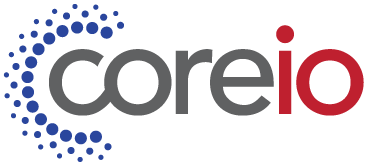In my role as Chief Operations Officer here at Coreio, I’ve observed that while some companies choose to leave the majority of technology troubleshooting for common hardware and software issues in the end user’s hands, most enterprise-scale organizations recognize that the hidden costs of unproductive downtime baked into that approach. For our clients, the cost of having valuable team members spend time working on solving their technology issues rather than doing their jobs is just too high. Reputation management for an enterprise’s IT organization can also be harmed when enterprise end users feel unsupported.
Traditionally, we have understood that for end users to feel their organization’s IT team is supporting them, whether in addressing a hardware or software issue or completing the installation of a new asset, requires that the IT team in contact with the user assume full ownership of the incident or request, providing updates as they work to complete the necessary actions, but otherwise largely cutting the end user out of the solution. Whether through remote takeover of the desktop, or a dispatched visit to replace a component or diagnose a software issue, the end user remained focused on their duties while IT took care of the issue.
One of the most important aspects of my job is leading the evolution of our Client Delivery business. That means I am strongly focused on ensuring our services meets our end user clients’ IT needs today but also that we are positioned to meet their needs in the future, to ensure we continue to offer a second to none experience for them that enhances the reputation of our client partners.

Coreio’s Chief Operations Officer, Rob Muroff
Changing Workforce Demographics Up-ending Traditional Service Delivery Models
What we are finding more and more is that as the workforce moves from majority “baby boomer” (born before 1963) populations, through “Generation X” (born 1963-1980) to the growing “Millennial” (born 1980-1995) domination of the workforce, our end user clients are changing in terms of their tech savviness, certainly, but also in terms of their expectations of the enterprise IT team. Not content to sit on the sidelines, the new generation of enterprise workers are voicing a desire to participate in solutioning their IT issues, all in the effort to get back to productivity faster. Satisfying this new highly adaptable, tech savvy and very independent client requires a new approach.
How to Enable and Support the Coming Wave Better
The rise of the Millennial generation in the enterprise workforce is exciting to witness. This new generation, currently age 22-37, is statistically larger than the Baby Boomers and dwarfs my own cohort of Gen Xers, at an amazing three times the size. Less than 20 years from now, by 2035, Millennials will account for 75% of the total global workforce. They were born into a truly global work culture in which technological change was already rampant, and grew up never knowing a world without the Internet, mobile devices and instant on-demand access to information. It’s not surprising that they are often described as information sponges who expect immediate answers to problems/questions. And because they’ve enjoyed access to efficient web-based tools, they tend to be “Do It Yourself”-oriented, preferring Self-Service portals and independent learning options (think YouTube tutorials) over assisted service.
What we’ve observed has informed our support model evolution. What does this new generation of end users need from IT support services? We think it comes down to 5 things:
- Recognition of their competence: Millennials are past the basics of being asked if they’ve tried rebooting, and will tune you out if they feel they’re being underestimated when addressing technology.
- Speed and Efficiency: Because they are time-poor, it’s important to establish how our role is to take ownership of the process of incident management in order to speed resolution on their behalf.
- Trust in the System: The ability to trust that the support they receive will effectively return them to a working state.
- Empowerment: The power to resolve their own problems where appropriate, so they can address common issues themselves (like setting up a new system).
- Appropriate Back End Governance: Checks and balances to ensure their self-management doesn’t contravene corporate governance (so that new system should arrive with appropriate configuration and imaging protocols in place).
How We Are Innovating to Support Time-Poor, Tech-Savvy Millennials
“White glove” support is a touchstone in the Desktop Support industry. For as long as the industry has been around, the gold standard has been in-person support, initiated through a service ticket, that is essentially turn-key for the end user. The user turns over the device to a technician, and it is returned in a functional state, with maybe a bit of coaching added. The coming work force majority I’m describing neither needs that high-touch service model nor wants it. Here at Coreio, we are responding to that change in a few key ways, both in our internal support model for our own team members, and our service delivery to our enterprise clients.
Like many organizations, we are integrating self-service tools into our internal support structures more and more. While it makes good business sense in terms of efficiency gains, it’s also increasingly driven by the preferences of our staff here. As we automate more and more internal support functions, we see a reduction in service tickets, certainly, but also positive feedback measured through survey responses. We attribute this self-service orientation to our internal users’ “need for speed.” Rather than calling a helpdesk, opening a ticket, and waiting for a deskside tech to arrive, our users have seen the value of help at their fingertips that returns them to productivity in minutes. Call it the rise of the eTrade generation over the generation who would call a stock broker. And of course, everything is mobile-enabled so our users can get help on the go.
Our clients are investing in self-service support portals as well, but when hands-on support is needed, they are finding that there are still options other than the traditional ITSM Help Desk workflow. One model of service delivery we have pioneered with a few of our enterprise client partners is the “Tech Lounge.” Dedicated spaces in the office are staffed with technicians who provide support to end users on a drop-in model. It’s all very informal, and it’s also very fast. No tickets, no waiting. Users still get the high touch experience when support issues dictate the need for direct intervention, but it’s less process bound. We’ve seen great success with this.
Before Providing Support, Ensure It’s the Right Support
Times are changing. Today, we believe it’s essential for IT support team members to evaluate not only the end user’s issue—the immediate reason they need support–but their capability level—the extent of the support required to resolve the issue based on the individual. Our playbooks need to be flexible so we can scale our support to account for high-needs and low-needs users, which broadly speaking may conform to generational models (but not exclusively).
It’s incumbent on the IT services industry to help today’s enterprises protect their bottom line and their organizational effectiveness with responsive, tailored end user support that gets individual users back to peak performance quickly and effectively. However, IT service providers and their client organizations need to evolve their service delivery model to address the evolution of the end user. So long as these three very different generations coexist in the workforce, one size fits all frameworks for IT support don’t make sense. We are servicing user bases with different levels of technological acuity, certainly, but also different expectations of our services. It’s our job to meet them all.

Recent Comments